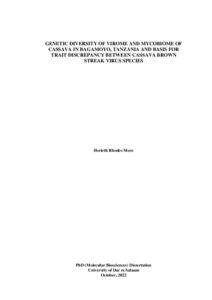| dc.contributor.author | Mero, H.R. |
| dc.date.accessioned | 2023-03-03T09:27:49Z |
| dc.date.available | 2023-03-03T09:27:49Z |
| dc.date.issued | 2022-10 |
| dc.identifier.citation | Mero, H.R. (2022). Genetic diversity of virome and mycobiome of cassava in Bagamoyo, Tanzania and basis for treat discrepancy between cassava brown streak virus species. Dar es Salaam, Tanzania: University of Dar es Salaam. (351 p.). |
| dc.identifier.uri | https://hdl.handle.net/20.500.12478/8076 |
| dc.description.abstract | Brown streak is the most destructive viral disease of cassava causing up to 100% yield loss whilst fungal diseases contribute up to 90% cassava yield loss in Sub Saharan Africa. Genetic diversity of novel virus and fungal species infecting cassava in Bagamoyo, Tanzania is not fully comprehended. For unclear reasons, it is difficulty to breed resistance for one causal pathogen of cassava brown streak disease (CBSD), Cassava Brown Streak Virus (CBSV) compared to another, Ugandan Cassava Brown Streak Virus (UCBSV) species. Furthermore, genetic basis for trait discrepancy between the two virus species is elusive. CBSD-resistance status of the improved KBH 2006/0026 genotype of cassava in Bagamoyo, Tanzania is controversial because sporadic outbreak of the disease has become common in the genotype since 2019, even though it was previously reported to exhibit maximum resistance to infection by both CBSV and UCBSV species within 2014 - 2017 period. Metatranscriptomic, time-series transcriptomic and in silico studies were conducted to understand diversity of virome and mycobiome of cassava in Bagamoyo Tanzania, resistance status of KBH 2006/0026 and basis for trait discrepancy between the CBSV and UCBSV species, correspondingly. This study reports for the first time, incidence of Manihot esculenta associated virus 1 (MEAV-1) belonging to Ampelovirus genus and Closteroviridae family in Kiroba genotype. Twenty-two fungal species were also identified from cassava leaves in Bagamoyo fields; some are pathogenic/mycotoxic whilst others have potential applications in medicine, food and pharmaceutical industries. This study has discovered that the CBSV and UCBSV species express Second 6-Kilodalton (6K2) protein with varied 3D structures and polarity, suspected reason for discrepancy in tissue titres and replication rate between them. By experimentation it was proved that, KBH 2006/0026 is no longer CBSD-resistant. This study suggests that: multiplex reverse transcription polymerase chain reaction (RT-PCR)-based assay needs to be developed and used for accurate diagnosis of multiple virus species causing the CBSD, 6K2 should be targeted for transgenesis of virus-specific, resistant cassava by RNA interference (RNAi) technology. Equally, fungal-resistant cassava needs to be produced and used. |
| dc.description.sponsorship | Swedish International Development Cooperation Agency |
| dc.format.extent | 351 p. |
| dc.language.iso | en |
| dc.publisher | University of Dar es Salaam |
| dc.subject | Cassava |
| dc.subject | Plant Diseases |
| dc.subject | Genetic Diversity |
| dc.subject | Viruses |
| dc.subject | Plant Health |
| dc.subject | Tanzania |
| dc.title | Genetic diversity of virome and mycobiome of cassava in Bagamoyo, Tanzania and basis for treat discrepancy between cassava brown streak virus species |
| dc.type | Thesis |
| cg.contributor.affiliation | University of Dar es Salaam |
| cg.contributor.affiliation | International Institute of Tropical Agriculture |
| cg.coverage.region | Africa |
| cg.coverage.region | East Africa |
| cg.coverage.country | Tanzania |
| cg.coverage.hub | Eastern Africa Hub |
| cg.researchtheme | Plant Production and Health |
| cg.identifier.bibtexciteid | MERO:2022 |
| cg.authorship.types | CGIAR and developing country institute |
| cg.iitasubject | Agronomy |
| cg.iitasubject | Cassava |
| cg.iitasubject | Food Security |
| cg.iitasubject | Plant Breeding |
| cg.iitasubject | Plant Diseases |
| cg.iitasubject | Plant Health |
| cg.iitasubject | Plant Production |
| cg.notes | IITA supervisor: Dr. Legg, J. |
| cg.publicationplace | Dar es Salaam, Tanzania |
| cg.accessibilitystatus | Limited Access |
| cg.reviewstatus | Internal Review |
| cg.usagerightslicense | Copyrighted; all rights reserved |
| cg.targetaudience | Scientists |
| cg.futureupdate.required | No |
| cg.contributor.acknowledgements | Swedish International Development Cooperation Agency (SIDA) is highly appreciated for financing the current study.
Special gratitude goes to my employer, University of Dar es Salaam, Mkwawa University College of Education (MUCE) for the given opportunity to pursue my PhD study.
Eastern Hub of International Institute of Tropical Agriculture (IITA) is highly appreciated for research support especially, access to field trials for sample collection, use of screen house for experimentation, molecular biology laboratory for sample analysis and storage. Dr. James Peter Legg is thanked for his immeasurable support and guidance in designing and conducting screen house experiments at the IITA. Whole-hearted thanks go to Professor Sylvester Leonard Lyantagaye and Professor Erik Bongcam-Rudloff, for their remarkable supervisory support and guidance throughout conduction of the present study.
Mr. Omary Ally Salumu is equally appreciated for his outstanding work and support throughout conduction of the experiment in the screen house. Mathias Ndalahwa and Isaya Sheria are highly appreciated for their support during field-based sample collection in Bagamoyo, Coast region of Tanzania. Dr. Anna Darlene Van Der Heiden is thanked for her support during sample analysis at molecular biology laboratory of the Swedish University of Agricultural Sciences (SLU), Sweden.
Dr. Juliette Hayer and all members of the Swedish University of Agricultural Sciences Global Bioinformatics Centre, at the Department of Animal Breeding and Genetics and Swedish University of Agricultural Sciences bioinformatics Infrastructure (SLUBI), Sweden are acknowledged for their support during analysis of high-throughput Next Generation sequence (HT-NGS) data.
I am very grateful to have received support, love and care from my beloved family members (Mr. Amani Swalehe Kipokola, Vivienne Amani Kipokola, Nathan Amani Kipokola, Dr. Rhodes Noel Mero, Calista Joseph Assenga, Bentha Kilenga, Eric Rhodes Mero, Samson Rhodes Mero and Pendo Elias Mmary) during conduction of the present study. |

